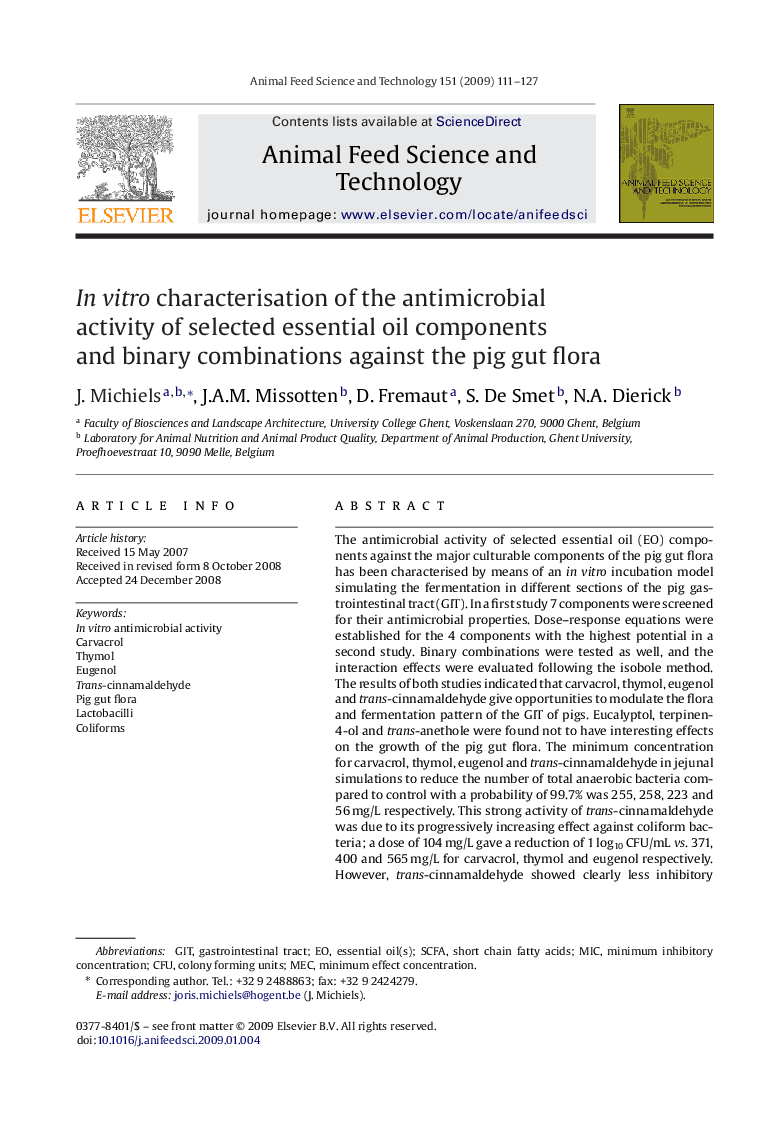| کد مقاله | کد نشریه | سال انتشار | مقاله انگلیسی | نسخه تمام متن |
|---|---|---|---|---|
| 2420292 | 1552458 | 2009 | 17 صفحه PDF | دانلود رایگان |

The antimicrobial activity of selected essential oil (EO) components against the major culturable components of the pig gut flora has been characterised by means of an in vitro incubation model simulating the fermentation in different sections of the pig gastrointestinal tract (GIT). In a first study 7 components were screened for their antimicrobial properties. Dose–response equations were established for the 4 components with the highest potential in a second study. Binary combinations were tested as well, and the interaction effects were evaluated following the isobole method. The results of both studies indicated that carvacrol, thymol, eugenol and trans-cinnamaldehyde give opportunities to modulate the flora and fermentation pattern of the GIT of pigs. Eucalyptol, terpinen-4-ol and trans-anethole were found not to have interesting effects on the growth of the pig gut flora. The minimum concentration for carvacrol, thymol, eugenol and trans-cinnamaldehyde in jejunal simulations to reduce the number of total anaerobic bacteria compared to control with a probability of 99.7% was 255, 258, 223 and 56 mg/L respectively. This strong activity of trans-cinnamaldehyde was due to its progressively increasing effect against coliform bacteria; a dose of 104 mg/L gave a reduction of 1 log10 CFU/mL vs. 371, 400 and 565 mg/L for carvacrol, thymol and eugenol respectively. However, trans-cinnamaldehyde showed clearly less inhibitory activity towards lactobacilli than carvacrol and thymol. Therefore, the use of trans-cinnamaldehyde (for example 100 mg/L) and to a lesser extent eugenol could result in a shift in the microbial ecology in favour of lactic acid producing bacteria and reducing the number of coliform bacteria. Carvacrol and thymol showed very similar and non-selective antimicrobial properties. Their effect was more pronounced in acidic media and demonstrated a rapidly increasing bactericidal effect from a certain concentration on (400–500 mg/L in jejunal simulations). The inhibition of the production of total short chain fatty acids (SCFA) in jejunal simulations by these 4 candidates was related to their effect against coliform bacteria, however they did not alter the lactic acid and ammonia concentrations. Few combinations demonstrated synergism; most mixtures showed zero interaction or antagonism. Carvacrol + thymol (ratio ≥1) was synergistic against total anaerobic bacteria in jejunal simulations, however this effect was rather small. In caecal simulations, carvacrol, thymol and trans-cinnamaldehyde were equally effective while eugenol had an effect only on coliforms. These data on the in vitro antimicrobial activities of EO components give support for a better control of the gastrointestinal bacterial community and the design of alternative growth promoters. Their in vivo potential is also discussed.
Journal: Animal Feed Science and Technology - Volume 151, Issues 1–2, 12 May 2009, Pages 111–127